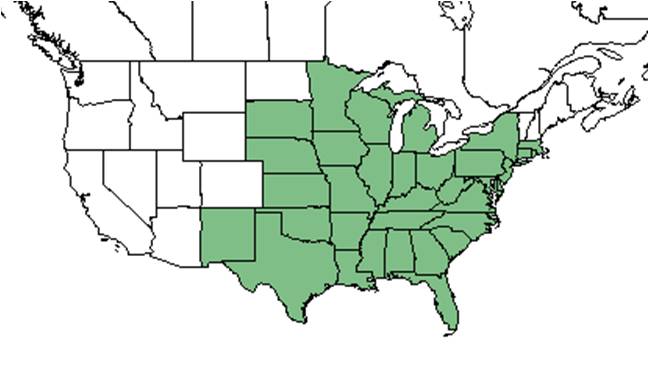Chamaecrista fasciculata
| Chamaecrista fasciculata | |
|---|---|

| |
| Photo taken by Michelle M. Smith | |
| Scientific classification | |
| Kingdom: | Plantae |
| Division: | Magnoliophyta - Flowering plants |
| Class: | Magnoliopsida - Dicotyledons |
| Order: | Fabales |
| Family: | Fabaceae ⁄ Leguminosae |
| Genus: | Chamaecrista |
| Species: | C. fasciculata |
| Binomial name | |
| Chamaecrista fasciculata (Michx.) Greene | |

| |
| Natural range of Chamaecrista fasciculata from USDA NRCS Plants Database. | |
Common name: partridge pea
Contents
Taxonomic notes
Synonyms: Chamaecrista fasciculata var. fasciculata; Chamaecrista littoralis Pollard; Chamaecrista mississipiensis (Pollard) Pollard ex Heller; Chamaecrista fasciculata; Cassia fasciculata Michaux var. puberula (Greene) J.F. Macbride; Chamaecrista puberula Greene
Description
Generally, in the group Chameacrista it includes trees, shrubs, or herbs. The leaves are evenly 1-pinnate with conspicuous gland(s) on the petiole or rachis. The flowers are either solitary or clustered in axillary racemes or terminal panicles, perfect. The calyx has an inconspicuous tube, 5 lobed, equally imbricate, and often unequal. There are 5 petals and are a little unequal. The stamens 5-10, are often unequal and some are sterile or imperfect. The anthers are basifixed and opening by 2 apical pores. The legume is few-to many-seeded, often septate, and exceedingly variable. Including Chamaecrista Moench, Ditremexa Raf., Emelista Raf. (Radford 1964).
Specfically, for Chameacrista fasciculata, the species is an annual herb, growing 1.5-6 dm tall from the taproot. The stems and branches are glabrous to more commonly densely puberulent with incurved trichomes and occasionally also with villous trichomes to 2 mm long. The leaves are sensitive with a sessile, depressed, saucer-shaped gland, 0.5-1.5 mm in diam. near the middle of the petiole. Leaflets 12-36, linear-oblong, 1-2.5 cm long, 2-6 mm wide, inequilateral; stipules persistent, striate. Inflorescence are 1-6 flowered axillary fascicle. Pedicels grow up to 1-2 cm long. Sepals are lanceolate in shape, growing 9-12 mm long, and are acute. Petals are bright yellow in color, almost equal, growing 1-2 cm long; stamens 10, unequal, growing 10-13 mm long. The legume are elastically dehiscent, growing 3-7 cm long, and 5-7 mm broad, and are glabrate or appressed-puberulent to villous (Radford 1964).
Distribution
Ecology
Seed dispersal
According to Kay Kirkman, a plant ecologist, this species disperses by being consumed by vertebrates (being assumed). [1]
Pollination
The following Hymenoptera families and species were observed visiting flowers of Chamaecrista fasciculata at Archbold Biological Station (Deyrup 2015):
Apidae: Apis mellifera, Bombus impatiens
Halictidae: Augochlora pura, Augochloropsis metallica, A. sumptuosa, Lasioglossum coreopsis, L. placidensis
Megachilidae: Coelioxys sayi, Megachile mendica, M. texana
Vespidae: Stenodynerus histrionalis rufustus
Conservation and Management
Cultivation and restoration
Photo Gallery
References and notes
Deyrup, M.A. 2015. Database of observations of Hymenoptera visitations to flowers of plants on Archbold Biological Station, Florida, USA.
Radford, Albert E., Harry E. Ahles, and C. Ritchie Bell. Manual of the Vascular Flora of the Carolinas. 1964, 1968. The University of North Carolina Press. 577-8. Print.
- ↑ Kay Kirkman, unpublished data, 2015.